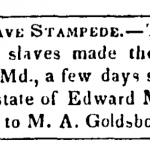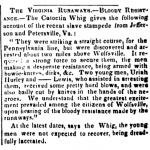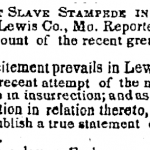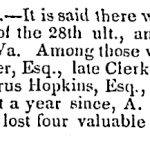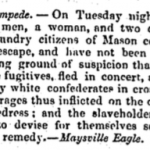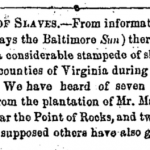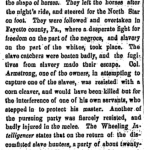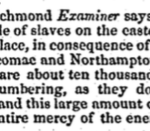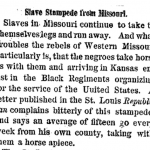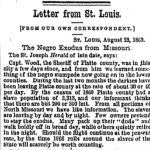Search Summary
- Search conducted by Cooper Wingert during week of Nov. 26-30, 2018
- Keywords: slaves and stampede(s) (both singular & plural) and stampeding, but found * (stamped*) didn’t work so well (too many false positives on the word, “stamped”), plus variants including negro, servile, fugitive, and exodus
- Totals: About 160 hits with concentrations reported from Kentucky, northern Virginia, Maryland and eastern Missouri.
Top Results
- “Slaves are running away from Missouri, at the present time, in battalions,” reported the Alton (IL) Telegraph in the spring of 1853. Situated just miles from Missouri’s eastern border, the paper’s readers were already quite familiar with the term “Slave Stampedes,” which was the headline used for this and countless other articles. (Alton Telegraph, quoted in The Liberator, June 10, 1853)
- A correspondent for the London Times took special note of the term, writing that stampede was “a word which the Americans have borrowed from their prairies, and applied most expressively to a general rush of negroes from slavery.” (London Times, June 19, 1861, quoted in “English Speculation on the War and its Issue,” New York Herald, July 2, 1861)
- Under the headline, “NEGRO STAMPEDE,” The Cleveland Daily Herald reported (in its entirety) on November 19, 1859: “The Chicago Journal says that on Thursday evening, the 17th inst., the underground railroad arrived there with thirty passengers, five from the vicinity of Richmond, Va., twelve from Kentucky, and thirteen from Missouri. They are now all safe in Canada. The thirteen from Missouri were sold to go down the river, the very day they started. A stalwart six-footer and a Sharp’s rifle were the only guides.” (Cleveland Daily Herald, November 19, 1859).
- The Democratic New York Herald once wrote of “servile stampedes,” while a Cincinnati newspaper describing the movements of Kentucky slaves used the terms “stampede” and “negro exodus” interchangeably. (“The South and Southern Safety–A New Presidential Programme,” New York Herald, December 4, 1859; “Kentucky Negro Exodus,” Daily Cleveland Herald, June 6, 1864)
- Many hits contained only brief mentions, such as an Ohio newspaper’s succinct remark that “stampedes of slaves, from Mason and Nicholas counties, Ky. seem of common occurrence.” (“Items,” The Daily Scioto Gazette, Chillicothe, OH, May 8, 1851)
- Then there was a New Hampshire newspaper, which in August 1850 ran a short article entitled “Slave Stampedes.” For a New England audience that was perhaps unfamiliar with the term, the editor conveniently took the time to offer up a definition: “an uprising and fleeing from bondage of a large number of slaves.” (“Slave Stampedes,” New Hampshire Statesman, Concord, NH, August 30, 1850)
- As early as 1849, newspapers began using the headline “Another Slave Stampede,” underscoring just how common stampedes were (see Mississippi Free Trader and Natchez Gazette, December 15, 1849). A decade later, the editor of the Charleston Mercury underscored this point, writing that stampedes described slaves who escaped “in startling numbers” on a near “daily” basis. “They go off, one, two, three, or a dozen at a time.” (“Slavery in Kentucky,” Charleston Mercury, May 10, 1858). These types of headline and comments reappeared straight through into the Civil War “Almost every day we hear of a new stampede of slaves in our county,” groused an editor from Port Tobacco, Maryland in September 1863. “Indeed, so frequent have they become of late, that no surprise or comment is excited hereby.” (Port Tobacco Times, quoted in “”Emancipation in Maryland,” Milwaukee Daily Sentinel, September 17, 1863).
Select Images
- Mississippi Free Trader and Natchez Gazette, December 15, 1849.
- Mississippi Free Trader and Natchez Gazette, September 29, 1849.
- Philadelphia North American and United States Gazette, November 22, 1849.
- New Hampshire Statesman, August 30, 1850
- Boston Investigator, August 18, 1852.
- The Liberator, September 24, 1852.
- Hannibal Missouri Courier, November 10, 1853.
- Jackson Mississippian, April 20, 1858.
- Milwaukee Sentinel, November 12, 1858.
- The Liberator, January 10, 1862.
- Cleveland Herald, May 7, 1863.
- San Francisco Daily Evening Bulletin, September 16, 1863.
General Notes
- 19th-Century Newspapers is a subscription database from Gale available to students only through the Dickinson College Library Database Finder
- The term took on a new life in the wake of John Brown‘s failed Harpers Ferry insurrection in October 1859. No less than 11 stampede-related articles dealt with Harpers Ferry. Barely a week after the botched uprising, the Democratic New York Herald published a batch of correspondence between Brown and fellow abolitionists, which was quickly picked up and reprinted by other papers. Among the correspondents was an English-born abolitionist named Hugh Forbes, a one-time ally of Brown who ultimately backed out of the plot. The search engine picked up on Forbes’s plan to instigate “a series of stampedes of slaves,” which he predicted would each “carry off in one night, and from the same place some 20 to 50 slaves.” (“News and Further Developments,” Newark Advocate, Newark, OH, November 4, 1859) In the wake of Harpers Ferry, slave stampedes were closely linked with other revolutionary acts, often appearing in conjunction with words such as insurrection, revolt and rebellion. A Jackson, Mississippi paper closely associated the term with armed revolt, complaining of “slave insurrections or slave stampedes.” (“Abolitionism of 1835 and of 1859,” Semi-weekly Mississippian, Jackson, MS, December 27, 1859) Similarly, citizens of Madison County, Kentucky, expressed suspicion that abolitionists were creeping into their community, “exciting insurrection and getting up stampedes among the slaves.” (“The Disturbances in Madison County, KY.,” Bangor Daily Whig & Courier, Bangor, ME, April 12, 1860)
- The coming of the Civil War saw a similar spike in usage, as countless Northern papers speculated on the war’s impact on Southern slaves. Many articles used the term “general stampede,” predicting that such “a general stampede” of slaves would occur “as the war is carried into the enemy’s country, and slavery will abolish itself.” (Springfield Republican, quoted in “Let us Learn to Wait,” New Hampshire Statesman, November 30, 1861) Even in the Confederacy’s capital, a Richmond paper admitted that the presence of “a Yankee army creates as complete a stampede among negroes as the approach of a locomotive among cattle.” (Richmond Dispatch, September 22, 1862, quoted in Philadelphia North American and United States Gazette, October 3, 1862)
Most Relevant Coverage from 19th-Century US Newspapers
- MISSOURI: Missouri Courier, Hannibal, MO – 1849-1853 (Democratic, pro-slavery)
- MISSOURI: St. Louis Missouri Republican (but with major gaps) (Democratic, pro-slavery)
- ILLINOIS: None from period 1840 – 1860
- MASSACHUSETTS: The Liberator, Boston, MA – 1852-1862 (anti-slavery)
- NEW YORK: New York Herald – 1861 (Democratic, pro-slavery)
- OHIO: Cleveland Herald – 1848-1863 (Whig and Republican, anti-slavery)


